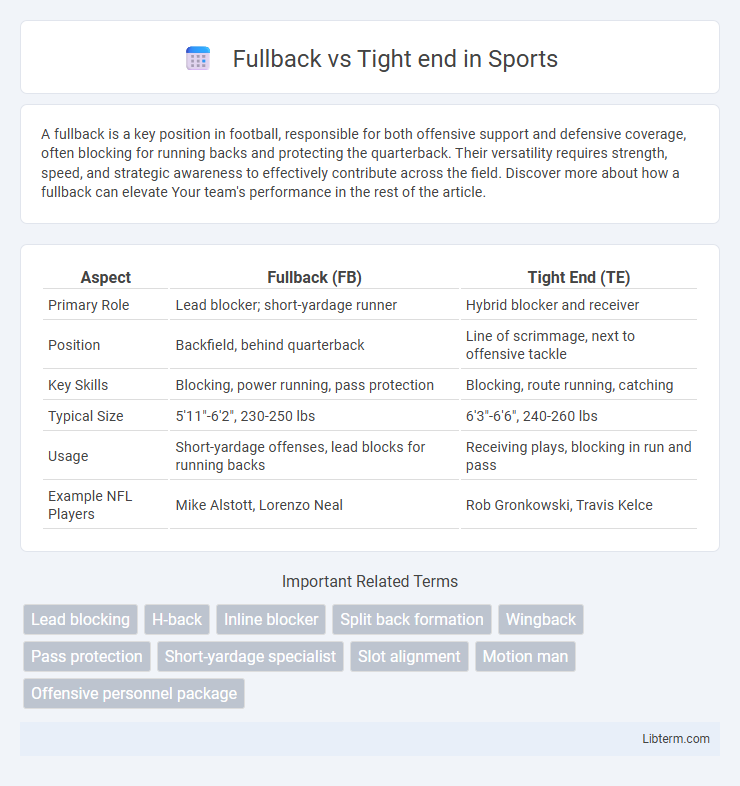A fullback is a key position in football, responsible for both offensive support and defensive coverage, often blocking for running backs and protecting the quarterback. Their versatility requires strength, speed, and strategic awareness to effectively contribute across the field. Discover more about how a fullback can elevate Your team's performance in the rest of the article.
Table of Comparison
| Aspect | Fullback (FB) | Tight End (TE) |
|---|---|---|
| Primary Role | Lead blocker; short-yardage runner | Hybrid blocker and receiver |
| Position | Backfield, behind quarterback | Line of scrimmage, next to offensive tackle |
| Key Skills | Blocking, power running, pass protection | Blocking, route running, catching |
| Typical Size | 5'11"-6'2", 230-250 lbs | 6'3"-6'6", 240-260 lbs |
| Usage | Short-yardage offenses, lead blocks for running backs | Receiving plays, blocking in run and pass |
| Example NFL Players | Mike Alstott, Lorenzo Neal | Rob Gronkowski, Travis Kelce |
Introduction to Fullbacks and Tight Ends
Fullbacks and tight ends are key positions in American football, each serving distinct roles in offense. Fullbacks primarily function as lead blockers and short-yardage runners, supporting the running game and protecting the quarterback. Tight ends combine the skills of offensive linemen and receivers, blocking for the run while also serving as reliable targets for passes in various offensive schemes.
Historical Evolution of Both Positions
Fullbacks initially emerged as key blockers and short-yardage runners in early football formations, evolving from primarily power-focused roles into more versatile players contributing to both rushing and receiving. Tight ends developed from traditional ends lining up on the line of scrimmage, gradually transforming into hybrid athletes capable of blocking like linemen and running routes like wide receivers. Over time, offensive strategies and rule changes have expanded the tight end's role in passing offenses, while the fullback's presence has diminished in many modern schemes, emphasizing specialized skills and adaptability.
Core Responsibilities of Fullbacks
Fullbacks primarily serve as lead blockers in running plays, clearing paths for the running back by engaging linebackers and defensive linemen. They are also tasked with short-yardage rushing and pass protection, ensuring quarterback safety against blitzes. While tight ends split their focus between receiving and blocking, fullbacks concentrate on creating space and maintaining offensive momentum through physical blocking.
Key Roles of Tight Ends
Tight ends serve a dual role by combining the blocking responsibilities of a fullback with the receiving capabilities of a wide receiver, making them versatile assets in both the run and pass game. Their key roles include pass-catching, providing crucial run-blocking support for running backs, and acting as additional pass protectors to safeguard the quarterback. Tight ends often exploit mismatches against linebackers and safeties, leveraging their size and agility to create strategic advantages in offensive formations.
Physical Attributes and Skillsets Compared
Fullbacks typically possess a stockier, more muscular build optimized for powerful blocking and short-yardage runs, while tight ends combine size with agility, often standing taller and benefiting from a leaner frame to excel in route running and receiving. Fullbacks emphasize strength, leverage, and blocking technique to create running lanes, whereas tight ends require a versatile skill set that includes reliable hands, route-running precision, and the ability to both block and catch passes effectively. The physical and skillset distinctions position fullbacks primarily as lead blockers and short-yardage rushers, while tight ends serve as hybrid players bridging offensive line support and receiving corps capabilities.
Involvement in Blocking Schemes
Fullbacks are primarily involved in blocking schemes as lead blockers for running backs, often paving the way in short-yardage and power-running situations. Tight ends serve dual roles by blocking on the line to protect the quarterback and seal the edge in running plays while also acting as eligible receivers. The tight end's versatility in blocking both linebackers and defensive ends enhances offensive formations, whereas fullbacks focus more on interior line engagement.
Receiving Capabilities: Fullback vs Tight End
Tight ends possess superior receiving capabilities compared to fullbacks, often acting as primary targets in the passing game due to their size, speed, and route-running skills. Fullbacks primarily serve as blockers but can contribute in short-yardage or safety valve receiving situations, typically running shorter, less complex routes. The tight end's versatility in both blocking and receiving positions them as more effective and dynamic pass-catching threats on the field.
Strategic Uses in Modern Offenses
Fullbacks primarily serve as lead blockers and short-yardage runners, enhancing running game efficiency and pass protection in modern offenses. Tight ends offer versatile roles as both key blockers on the line and dynamic pass catchers, creating mismatches against linebackers and defensive backs. Offensive schemes leverage fullbacks to sustain drives and tight ends to exploit coverage gaps, optimizing team versatility and tactical execution.
Notable Fullbacks and Tight Ends in NFL History
Notable NFL fullbacks like Mike Alstott and Lorenzo Neal redefined blocking and versatility, contributing significantly to their teams' rushing attacks and pass protection. Legendary tight ends such as Tony Gonzalez and Rob Gronkowski revolutionized the position with exceptional receiving skills, setting numerous records in receptions and touchdowns. Both positions have showcased a blend of strength and athleticism, influencing offensive strategies throughout NFL history.
Choosing Between Fullback and Tight End for Your Team
Selecting between a fullback and a tight end depends on your team's offensive strategy and personnel needs. Fullbacks excel in blocking and short-yardage situations, providing strong lead blocks for running backs and pass protection, while tight ends offer more versatility with route-running, pass-catching, and edge blocking. Evaluating your team's play style and roster balance will help determine whether a power-focused fullback or a multifaceted tight end better complements your offense.
Fullback Infographic

 libterm.com
libterm.com